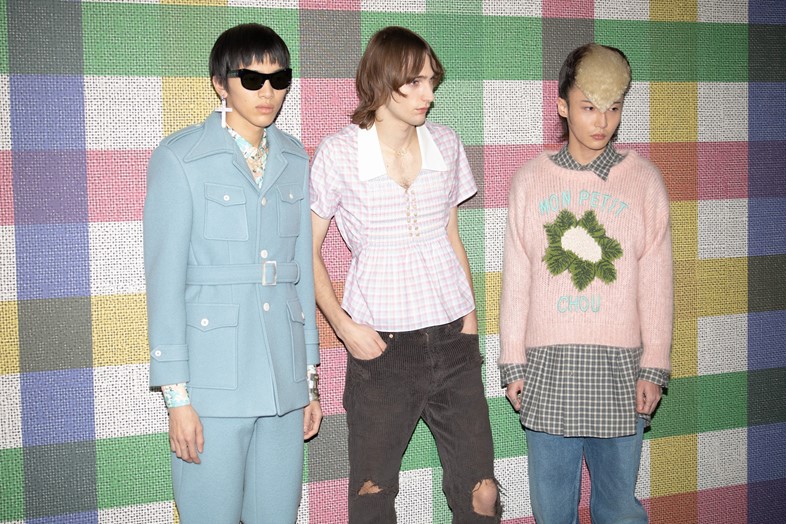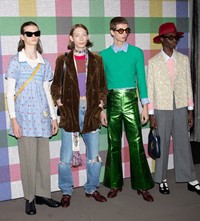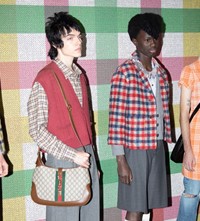Yesterday in Milan, Alessandro Michele invited show-goers to his “fifth birthday rave” – a celebration of five years at the helm of Gucci where the designer presented a collection entitled ‘Masculine Plural’
- TextJack Moss
It has been a brief five years since Alessandro Michele, then-unknown, presented his debut collection for Gucci; his forebear, Frida Giannini, had left earlier than expected, he, previously her deputy, took over. What followed was one of the definitive collections of the decade – a languorous, androgynous outing for men, complete with pussybow blouses, berets and mink-lined leather slippers, titled Urban Romanticism – which had been, so the lore goes, completed moments before it arrived on the catwalk. Michele had nothing to lose (just this week he revealed he was sure he would be fired) but his aesthete’s vision nonetheless prevailed, shifting the axis of fashion and going on to increase Gucci’s sales by double digits.
Yesterday he made a triumphant return to where it all started – Milan Men’s Fashion Week – having shown his mens- and womenswear together for several seasons. Certainly it felt like an occasion: the invitations, delivered prior to the show, were doily-edged notecards on which ‘you are invited to my fifth birthday rave, Ale’ was written in the designer’s own cursive (the accompanying hashtag: #RaveLikeYouAreFive). But, as the show begun – set amid amphitheatre-like seating, in the centre of which a giant silver pendulum swung in a figure-of-eight – it was clear that Michele was not simply turning the clock back to his first collection, but all the way back to childhood.
The title of the collection was Masculine Plural: “It’s time to celebrate a man who is free to practise self-determination, without social constraints, without authoritarian sanctions, without suffocating stereotypes,” read the typically manifesto-like show notes. “A man who is able to reconnect with his core of fragility, with his trembling and his tenderness.” Masculinity has been a preoccupation of Michele’s since his very first collection; here, he pushed it all the way back to its most nascent form, pre-adolescence, when the constricting boundaries of masculinity are yet to harden. So there were fluffy shrunken sweaters – one stitched with a hatching chick on which was written “mon petit” – baby-doll dresses and frilly peter pan collars, ditsy floral scarfs and brief schoolboy shorts (replete with knee-high socks), patterned lunchboxes and baby-blue knickerbockers.

Elsewhere, Michele hopped between epochs, settling much of the time on the 1990s (the booming soundtrack, by Steve Mackey, included Marilyn Manson’s 1995 cover of Sweet Dreams Are Made of This). Most prescient, though, was the influence of Seattle-born grunge: Kurt Cobain’s 1993 cover of The Face, on which he wears a buttoned-up tea dress, was surely on the season’s moodboard – ditto Courtney Love’s ‘kinderwhore’ stylings. In this vein, there were dishevelled sweater vests and baggy laundered plaid shirts, ripped denims jeans and dungarees. Little wonder that Michele recalled this fabled time: grunge was the antithesis of the machismo and misogyny of ‘glam metal’ which which flourished in the late 1980s (Guns ‘n’ Roses, Mötley Crüe and the like), replacing macho posturings with thoughtful introspection, where gender paradigms momentarily melted away. “Wearing a dress shows I can be as feminine as I want,” Cobain once said.
But, if the show was a rallying call against toxic masculinity – which “nourishes abuse, violence and sexism”, as the notes described – it was ultimately part of Michele’s continuing ode to the necessity of freedom (he noted after the show that his collaboration with British department store Liberty, the name of which was printed on the bags, had a satisfying double-entendre). And, as he enters his sixth year at the house, it is the same freedom that Michele seeks too – a desire to express himself, unbound from the stratospheric expectations his success has created. “I don’t know whether I’ll go on being as successful as I was in the beginning,” he said after the show. “I did what I wanted to do.”















